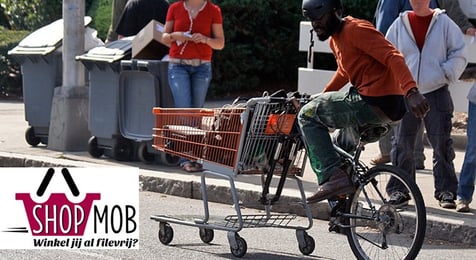The rush hours on our roads have slowly become commonplace, especially in relation to the commute between work and home. What we do not realize (yet) is that the same phenomenon exists within certain leisure activities, for example with the migration of shops. This way we create a temporary shortage of parking spots and long lines at the cash registers. Within the project ShopMob, we conducted a research focusing on our travel behavior while shopping and how we can make people aware of this in order to make adjustments. The results are available from today on.
 It is a known phenomenon. As we all go shopping together by car at the same moment, there is a shortage of parking spots at the shopping malls and big warehouses. However, at other times the parking spots are practically empty. This also results in busy and less busy moments in the shops. This is why we investigated how the Fleming’s store traffic can be spread out over time and be more sustainable. This based on studies, measurements, some pilot projects and a wide sensitization campaign.
It is a known phenomenon. As we all go shopping together by car at the same moment, there is a shortage of parking spots at the shopping malls and big warehouses. However, at other times the parking spots are practically empty. This also results in busy and less busy moments in the shops. This is why we investigated how the Fleming’s store traffic can be spread out over time and be more sustainable. This based on studies, measurements, some pilot projects and a wide sensitization campaign.
62% shops by car
A research based on the Research on Mobility behavior states that the average home to shop distance is 5,7 km. The majority (62%) goes by car, 18% takes the bicycle, 15% goes on foot and 3% takes the bus, tram or the metro. The choice of transport is strongly associated with the shop’s location. Shops that are near the center have more cycling customers than a shop adjacent to a big and busy road.
This also seems to be the conclusion of the vehicle readings that the project measured. The Colruyt branch in the south of Antwerp for example, which is in a zone 30, has no less than 45% of the costumers coming by foot or by bicycle. The Dansaert Retail Park in Groot-Bijgaarden, located near a highway, has 10-15% of its customers use public transportation thanks to a nearby tram stop.
Bicycle trailers and discount
The Colruyt Group posted flyers about the moments that are less busy in the shop for five months in five different warehouses to motivate their customers to spread their shopping behavior across different times and to let the car at home. Customers of some Collect&Go spots received a discount on their orders when picking them up during the off-peak hours and bicycle trolleys were available to 150 customers so they could shop car-free.
After questioning more than 400 customers, it seems that if the customer is aware of the peak and off-peak hours, he considers these to remodel his shopping behavior. 60% reported they actually need less time to get the shopping done during the quieter periods. The discount offered to the customers at the Collect&Go points for collecting their purchases during the off-peak hours has led to a shift in collection moments.
The satisfaction regarding the bicycle trolley is very high: 80% of them bought them at the end of the project. Even though most users already came by bicycle before, more than half of them take along more purchases and other products (like bigger packages) with the bicycle trolley. Just a minority comes less with the trolley than without.
Koen Valgaeren, general director of the research project: “The project shows that, if mediation happens through well thought-out offers and well-focused communication, the consumer can be convinced of the perks of shopping outside the peak-hours or to use the bicycle or public transport. Not only does this cause a monetary or time gain for the consumer, it brings with it many benefits for the retailer too: no overload on the parking area, a better planning for the retail-staff, and a better availability for the customers who do not (or not always) have access to a car for shopping.”
Attracting bicycle customers
Vic De Meester, Head of Environment-service of the Colruyt Group: “We wanted to take part in this project as we could see the mobility landscape evolve strongly. We are convinced that attracting more bicycle customers can be a benefit: they live nearby and come to shop often. Furthermore, they cause less traffic and hence there is smoother traffic in our parking areas and outside of it. On each site we are trying for a good incorporation of different transportation systems, we are trying to establish better and safer (separated) entrances for commuters by bicycle or on foot.”
As of October 2016, the VIM (Flemish Institute for Mobility) is part of Antwerp Management School as Expertise Center Smart Mobility. Interested in mobility? Read this as well!


